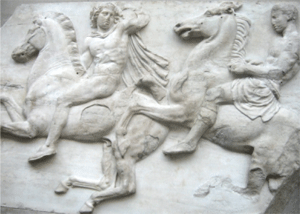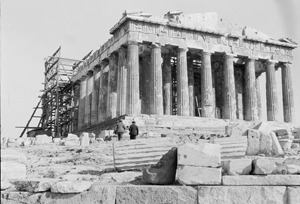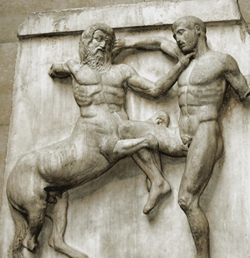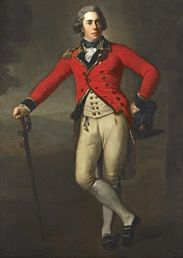|
The Elgin Marbles (or the Parthenon Marbles) are the sculptures and the bas-relief frieze residing in the British Museum that were acquired by Thomas Bruce, the 7th Earl of Elgin. In the early 1800s, Bruce served as the British ambassador to the Ottoman Turk Empire, which included Greece. At his own expense, he hired artists to draw and make plaster casts of the sculptures in the Parthenon to record these treasures before they were lost to history.
The Parthenon, the temple to Athena built on the Acropolis in Athens, was constructed between 447 B.C. and 438 B.C. It was made with 69 columns, each standing 34 feet high. A 40-foot statue of Athena made of hollow wood and ivory and gold dominated the interior. A frieze of sculptures more than 500 feet long lined the outer walls of the inner sanctum. “The frieze represented the Panathenaic procession held every fourth year when the citizens of Athens brought a new robe for the statue of Athena. The frieze was carved in low relief and was polychromed with a blue background.”1 Carved into it were 378 figures of men, women, children and Greek gods, and 245 animals. The Greek sculptor Phidias is credited with creating and supervising this colossal work of art.
In addition to being a temple to Athena, the Parthenon has also been used as Christian churches and an Islamic mosque over the years. During those times and across the centuries, many parts of the frieze and the figures in the metopes (rectangular sections in the frieze carved with sculptures) were destroyed or vandalized. Several of the sculptures and figures in the Elgin Marbles are missing heads or have been defaced.
|

A section of the Elgin Marbles in
the British Museum showing horsemen.
(Photo: Urban.)

The Parthenon, 1910-1920.
(Photo: Library of Congress.)
|
In 1687, the Venetians attacked Athens in a war against the Turks. The Parthenon was used as a gunpowder magazine by the Turks, thinking their enemy would not bombard this architectural wonder. Wrong. The Venetians fired their cannons on the Parthenon, and one shell ignited a gigantic explosion which destroyed the walls of the sanctum, toppled several columns, and knocked down half of the frieze and its sculptures. It was a historic and cultural tragedy.
When the Earl of Elgin arrived in the early 1800s, sculptures that had been knocked down or fallen from the triangular pediments on either end of the Parthenon were being taken by locals and burned to create lime for building their homes. Not expecting this archaeological treasure to survive, Thomas Bruce obtained an edict from the Turks to not only draw the sculptures but also to remove them. Some say bribery was involved in getting the edict and theft in taking the sculptures, but in the end, just under half of the original frieze of 524 feet, 15 metopes and 17 sculptures were preserved when he took them home.
However, they were almost lost on the voyage back. The ship carrying the Elgin Marbles was wrecked in a storm, and its cargo sank into the ocean near the Island of Kythera. The Marbles were eventually retrieved by divers, at further expense to the Earl.
|

|

|
|
A metope depicting a mythical battle between centaurs and Lapiths. (Photo: Adam Carr)
|
Thomas Bruce, the 7th Earl of Elgin
|
In 1816, Thomas Bruce sold the Marbles to the British government for £35,000 (about $3.1 million today), less than what he paid to have them removed and shipped home. The Elgin Marbles have resided in the British Museum for more than 200 years and are available there for viewing free of charge.
In 1832, Greece gained its independence with the help of Great Britain, France and Russia after being under Turkish rule for nearly 400 years. Since then, the Greek government has strenuously requested the return of the Parthenon Marbles from Great Britain, to no avail.
The Acropolis Museum in Athens holds about the same amount Marbles as the British Museum, but parts of sculptures are also in the Vatican and in museums in Germany, Austria, Italy and Denmark. (The “Copenhagen Marbles” are in the National Museum in Denmark. A Dane fighting with the Venetians who bombarded the Parthenon bought two marble heads from a street vendor, one of a centaur and the other of a Lapith, a race from Greek mythology.)
The ownership of the Elgin Marble is still hotly contested today. Was Thomas Bruce a savior or a thief? Would the Marbles he took be in a museum today if he had not taken them, or would they be destroyed or in private hands? Should the Elgin Marbles be returned to their homeland? Should the Greeks buy them back for $3.1 million? All we can do is wait and see.
Ted Carlton of Utah and Sherron Lawson of Roswell, Ga., correctly identified the Elgin Marbles.
----------------------------
1
Nichols State University, www.nicholls.edu, “The History of the Elgin Marbles: Past, Present and Future,” by Jessie Bangs.
References:
British Museum, www.britishmuseum.org.
Telegraph.co.uk, “The Elgin Marbles will never return to Athens – the British
Museum is their rightful home,” by Richard Dorment.
Http://ancient-greece.org/art/athena-statue.html.
|